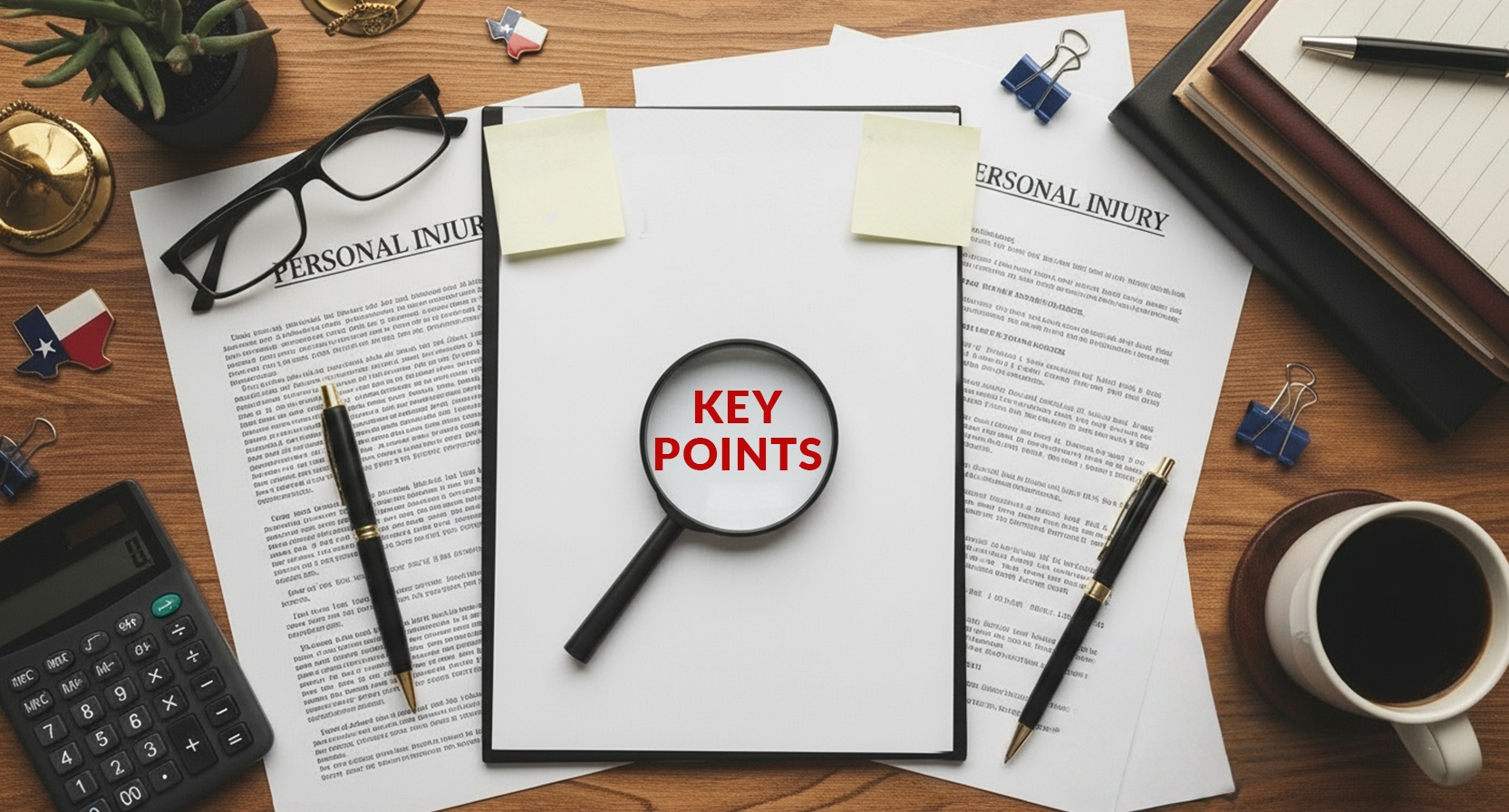Economic vs. Non-Economic Damages in Texas

When you are hurt in Texas because someone else made a mistake, you can ask for money to help. That money covers two main types: economic damages and non‑economic damages. These terms matter a great deal because understanding the difference helps you maximize the value of your case.
In Texas, laws like the Texas Civil Practice & Remedies Code guide how these damages work.
This article will show you:
- What economic damages are and how they show up in Texas.
- What non‑economic damages are, and how they show up in Texas.
- The key differences between these two types of damages.
- Texas‑specific rules you should know (like caps, fault, and documentation).
- How to build a strong claim for both kinds of damages.
- Frequently asked questions people have when dealing with economic vs non‑economic damages.
By the end, you’ll have a clearer idea of your rights in Texas and be better prepared to work with a lawyer or insurance adjuster.
1. What Are “Economic Damages” in Texas?
Economic damages are the measurable and documented losses you suffer after an injury. In Texas, under the Civil Practice & Remedies Code, these are called compensatory damages for actual economic or pecuniary loss.
1.1 Definition & Texas legal context
- Economic damages include things like medical bills, lost wages, future medical expenses, and property damage.
- The law says you have a right to recover these losses when someone else’s negligence causes your injury.
1.2 Common examples in Texas personal injury cases
Here are some typical economic damage items in Texas:
- Past medical expenses (hospital bills, surgery, rehab)
- Future medical care (if your injury needs long‑term treatment)
- Lost wages and loss of earning capacity (if you cannot return to your prior job)
- Property damage (for example, to your vehicle in an auto accident)
- Out‑of‑pocket expenses (travel to doctors, assistive devices)
1.3 How economic damages are calculated
To claim economic damages in Texas, you must support your claim with proof:
- Receipts, invoices, pay stubs, and bills help show medical bills and lost wages.
- For future losses, expert testimony or projections may be needed (for example, how your injury will reduce your earning capacity).
1.4 Why they matter in Texas claims
- Economic damages form the “hard numbers” in your claim—these are easier to show and value than intangible losses.
- You can use economic damages as a base when negotiating with insurance or in court.
- If you neglect to document these losses, you may leave money on the table in your settlement or verdict.
2. What Are “Non‑Economic Damages” in Texas?
Non‑economic damages are the intangible, non‑monetary losses you suffer after an injury. These include things like pain and suffering, emotional distress, loss of consortium, disfigurement, physical impairment, and loss of enjoyment of life.
2.1 Definition & legal meaning
- The law defines non‑economic damages as “damages … for physical pain and suffering, mental or emotional pain or anguish, loss of consortium, disfigurement, physical impairment, or loss of companionship and society, inconvenience, loss of enjoyment of life, injury to reputation, and all other nonpecuniary losses of any kind other than exemplary damages.”
- These damages do not include the measurable losses like bills and wages — those are economic damages.
2.2 Typical examples
Here are common types of non‑economic damages in Texas:
- Pain and suffering — physical discomfort from your injury and recovery.
- Emotional distress / mental anguish — such as anxiety, depression, fear, loss of self‑esteem.
- Loss of enjoyment of life — not being able to do hobbies or activities you once loved.
- Loss of consortium/companionship — the effect your injury has on your family or spouse’s relationship.
- Disfigurement or physical impairment — permanent scars, loss of mobility, or altered appearance.
2.3 How non‑economic damages are calculated (or estimated)
- Because non‑economic damages aren’t easily given a dollar amount like bills, courts use methods like the multiplier method (economic damages × a number) or the per diem method (daily rate × days of impact).
- Courts in Texas look at evidence such as the severity of injury, how long it lasts, impact on your day‑to‑day life, disfigurement, impairment, and emotional harm.
2.4 Why they matter (and why they’re tricky)
- Non‑economic damages often make up a large part of the value of a claim, especially if the injury is serious.
- Because they are subjective, insurance companies and adjusters often undervalue them or fight hard to reduce them.
- You need good documentation: photos, testimony, journals of pain, and expert evaluations for emotional injuries. Without strong proof, you may get less compensation.
3. Key Differences: Economic vs. Non‑Economic Damages

Here are the major differences between economic damages and non‑economic damages in Texas. Understanding these helps you build a stronger case and talk with insurers or lawyers more clearly.
3.1 Measurable vs. Intangible
- Economic damages are measurable losses: things like medical bills, lost wages, and property damage.
- Non‑economic damages deal with intangible losses: pain and suffering, emotional distress, loss of enjoyment of life, and loss of consortium.
3.2 Documentation Needs
- For economic damages, you need bills, receipts, pay stubs, or other financial records.
- For non‑economic damages, you rely more on testimony, journals, expert opinions, and showing how your life was changed.
3.3 Value Estimation
- Economic damages are easier to add up (you can total your bills, lost income, etc.).
- Non‑economic damages don’t have fixed numbers. In Texas, methods like the multiplier method or per diem method are used to estimate value.
3.4 Caps & Texas‑Specific Rules
- In many personal injury cases in Texas (car accidents, slip & fall), there is no cap on non‑economic damages.
- But in certain cases, like medical malpractice, non‑economic damages are capped under Texas law.
3.5 Strategy Implications
- Because economic damages are easier to prove, insurance companies often focus on those first.
- Non‑economic damages often require more effort to document, but they can make a big difference in the total value of your case if you don’t settle too early.
- Knowing the difference helps you recognize when a settlement offer is too low—especially if it covers your bills but not your pain, loss of enjoyment, or emotional harm.
4. Texas‑Specific Rules & Important Considerations
4.1 Caps on damages (and exceptions)
In Texas, there are limits on non‑economic damages in certain cases—particularly in medical malpractice claims. Under Texas Civil Practice & Remedies Code § 74.301, non‑economic damages are capped at $250,000 per claimant against a single healthcare provider. If multiple healthcare institutions are involved, the limit can be up to $500,000 total.
Importantly, economic damages (like medical bills, lost wages, and future medical expenses) are generally not capped in these cases. Exceptions and special rules apply: for example, in wrongful death or survival actions related to medical malpractice, additional caps can apply under § 74.303.
4.2 Comparative fault/responsibility in Texas
In Texas personal injury claims, fault or negligence plays a role. If you were partially responsible for your own injury, your total damages may be reduced based on the percentage of fault you bear. This affects both economic and non‑economic damages.
4.3 Statute of limitations in Texas
Timing matters. For most personal injury cases in Texas, you must file your claim within the statute of limitations (commonly two years from the date of the injury). If you wait too long, you may lose the right to recover either economic or non‑economic damages.
4.4 Future vs past damages
Both economic and non‑economic damages in Texas may include past losses and future losses.
- Past economic damages: hospital bills already paid, wages you already lost.
- Future economic damages: ongoing medical care, lost earning capacity.
- Past non‑economic damages: pain and suffering you already endured.
- Future non‑economic damages: diminished enjoyment of life going forward, emotional impact continuing.
4.5 Insurance and settlement insights
When dealing with insurance companies or when negotiating a settlement:
- Insurers often focus first on economic damages because these are easier to calculate and prove.
- Non‑economic damages are more subjective and harder to value — but they may represent a large part of the value of your claim.
- If your case involves medical malpractice, be aware of the caps on non‑economic damages so you understand your maximum possible recovery.
- Whether your case involves personal injury (non‑medical malpractice) or medical malpractice will affect whether a cap applies at all. Many personal injury cases (e.g., car accidents, slip & fall) may not have non‑economic caps.
5. How to Build a Strong Claim in Texas for Both Types of Damages

When you’re claiming both economic damages and non‑economic damages in Texas, you need to be organized, clear, and quick. The steps below help you claim the full value of your losses under laws like the Texas Civil Practice & Remedies Code.
5.1 Gathering evidence for economic damages
- Keep all your medical bills, receipts, invoices, pay stubs, and employer records for the time you missed work. These show your economic damage.
- If you expect future costs (for example, continuing medical care or loss of earning capacity), get expert reports or projections.
- For lost earnings, show how your injury changed your ability to work—this ties into loss of earning capacity.
5.2 Gathering evidence for non‑economic damages
- Document your pain and suffering, emotional distress, loss of enjoyment of life, disfigurement, loss of consortium, etc. Use journals, photographs, and video if possible.
- Use expert testimony when needed (psychologist, psychiatrist, pain specialist) to show long‑term impact.
- Show how your life has changed: hobbies, daily routines, relationships. This supports your non‑economic damage claim.
5.3 Working with an attorney familiar with Texas law
- Choose an attorney experienced in Texas personal injury and damage law. They’ll know local court rules, how statutes like damage caps work, and how to negotiate with insurance companies.
- The attorney will help you decide when to settle and when to go to trial, based on how well your economic and non‑economic damages are documented.
5.4 Negotiation & settlement timing tips
- Don’t rush to accept a settlement offer before you know all your losses (especially future ones). If you settle early, you may lose the chance for full compensation.
- Insurers may try to separate economic damages (easy to value) from non‑economic ones (harder to value) and give you a low offer for non‑economic losses. Your documentation matters.
- If your injury is serious, the non‑economic damages may be large, so make sure your submission shows the impact clearly.
5.5 What to ask your attorney/claim adjuster
- “What economic damages do I have documented so far?”
- “What non‑economic losses am I experiencing (pain, emotional, lifestyle changes)?”
- “Are there any caps in my case under Texas law?” (For example, in medical malpractice cases, non‑economic damages might be capped.)
- “What is the timeline for filing? Have we missed any deadlines?”
Frequently Asked Questions (FAQ)
Q1: What exactly counts as economic damages in Texas?
Economic damages cover the measurable, out‑of‑pocket losses you suffer when someone else’s negligence causes your injury in Texas. Examples include:
- Medical bills you already paid
- Future medical expenses you will need
- Lost wages from time off work
- Loss of earning capacity if your ability to work is reduced
- Property damage or other actual financial costs
Q2: What are examples of non‑economic damages I can claim?
Non‑economic damages cover the intangible harms from the injury—things you can’t easily put a number on. These include:
- Pain and suffering and physical discomfort
- Emotional distress, anxiety, or depression
- Loss of enjoyment of life (not being able to do what you used to)
- Loss of consortium or companionship with spouse/family
- Disfigurement or physical impairment
- Loss of household services or support
Q3: Are non‑economic damages capped in Texas?
It depends on the type of case:
- In many Texas personal injury cases (like auto accidents, slip & fall), there is no cap on non‑economic damages.
- But in medical malpractice cases under Texas law (for example, under Texas Civil Practice & Remedies Code § 74.301), non‑economic damages are capped at about $250,000 per defendant, and a total of about $500,000 when more than one provider is involved.
Q4: Can both economic and non‑economic damages include future losses?
Yes. Both types of damages can cover past and future losses:
- Economic: past medical bills, future medical treatment, future lost earning capacity.
- Non‑economic: past pain and suffering, future loss of enjoyment of life, long‑term emotional distress.
Q5: Does a partial fault affect my ability to recover damages in Texas?
Yes. Texas follows a modified comparative fault rule, which means: if you were partly at fault for your injury, your total recovery may be reduced in proportion to your fault. Both economic and non‑economic damages can be reduced accordingly.
Q6: How soon should I act if I want to file a claim for damages in Texas?
You should act promptly. For many personal injury cases in Texas, the statute of limitations is typically two years from the date of injury. If you delay, you may lose the right to claim both economic and non‑economic damages.
Q7: If the insurance company offers a settlement, should I accept it early?
Be cautious. Although some offers may seem fair, settling too early may mean you sacrifice full value, especially your non‑economic damages (pain, emotional harm, future loss). It’s wise to wait until you know the full scope of both economic and non‑economic losses before accepting.


